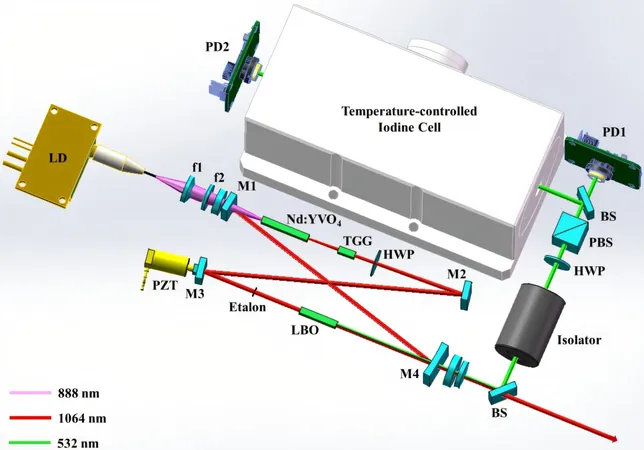
Revolutionary Iodine-Laser Technology Set to Transform Environmental Monitoring
2025-06-11
Author: Sarah
A Breakthrough in Laser Technology
In a groundbreaking advancement for atmospheric sensing, a team led by Prof. Zhang Tianshu at the Hefei Institutes of Physical Science, part of the Chinese Academy of Sciences, has unveiled a compact all-solid-state continuous-wave (CW) single-longitudinal-mode (SLM) laser that offers unprecedented frequency stability through pioneering iodine-based frequency locking.
What Makes This Laser Special?
The versatility of CW SLM lasers is remarkable, finding applications in fields ranging from laser amplification to gravitational wave detection and quantum optics. However, the critical need for frequency stability in atmospheric remote sensing and environmental monitoring has been a challenge for traditional semiconductor and fiber lasers, which struggle to adapt to variable environmental conditions.
Innovative Design Features
The research team tackled this issue by integrating a ring resonator structure with advanced iodine molecular absorption technology. This approach allows the laser frequency to be locked precisely to the edges of specific iodine absorption lines, using feedback mechanisms to finely adjust the resonator length for optimal stability.
Stellar Performance Metrics
The results are impressive: the new laser boasts exceptional beam quality, with M² values of 1.05 horizontally and 1.19 vertically, showcasing superb spatial coherence. Its output linewidth measures under 10 MHz—a clear indicator of stable single-longitudinal-mode operation. While the free-running mode exhibited a frequency drift exceeding 200 MHz, implementing frequency locking reduced this fluctuation to a remarkable 4 MHz over a continuous 7-hour duration.
Future-Ready for Environmental Applications
Beyond its technical prowess, this innovative laser system is designed for practical deployment, featuring a compact opto-mechanical-thermal-electrical architecture tailored for easy integration into field applications. This means it can efficiently support a range of environmental monitoring initiatives, potentially ushering in a new era of precision in atmospheric studies.


 Brasil (PT)
Brasil (PT)
 Canada (EN)
Canada (EN)
 Chile (ES)
Chile (ES)
 Česko (CS)
Česko (CS)
 대한민국 (KO)
대한민국 (KO)
 España (ES)
España (ES)
 France (FR)
France (FR)
 Hong Kong (EN)
Hong Kong (EN)
 Italia (IT)
Italia (IT)
 日本 (JA)
日本 (JA)
 Magyarország (HU)
Magyarország (HU)
 Norge (NO)
Norge (NO)
 Polska (PL)
Polska (PL)
 Schweiz (DE)
Schweiz (DE)
 Singapore (EN)
Singapore (EN)
 Sverige (SV)
Sverige (SV)
 Suomi (FI)
Suomi (FI)
 Türkiye (TR)
Türkiye (TR)
 الإمارات العربية المتحدة (AR)
الإمارات العربية المتحدة (AR)